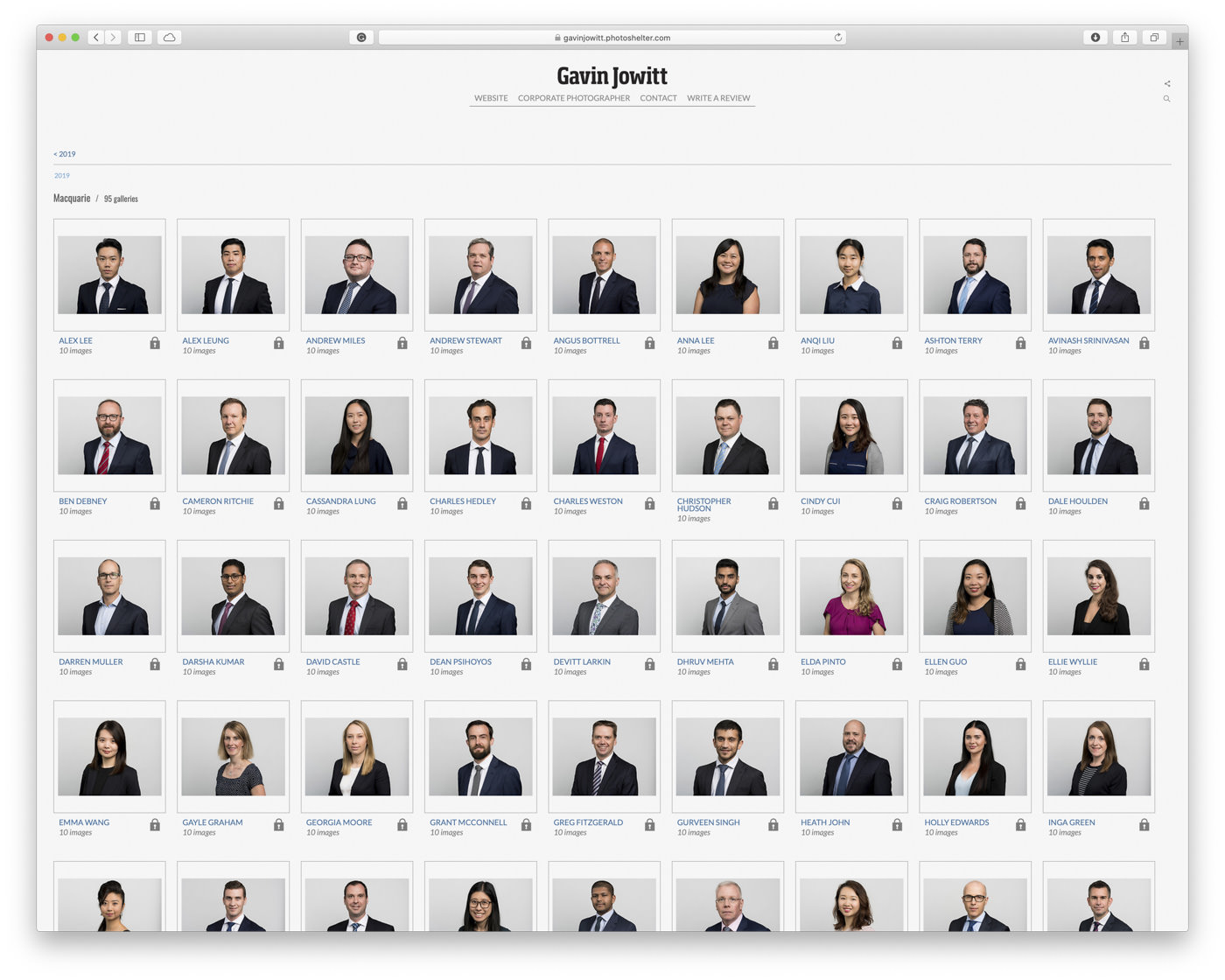
Shooting The Breeze is a photography blog by Gavin Jowitt, an award-winning Sydney-based photographer, offering valuable articles and advice on corporate, industrial, and architectural photography; life and photography in Sydney; and running a successful photography business.
Managing Your Corporate Image Library: Best Practices for Digital Asset Management

As a professional photographer, I have sometimes encountered situations where clients have misplaced the digital files I provided to them. This could be due to staff turnover, files being saved on an external hard drive, or hidden within a little-known directory on an extranet. If employees cannot locate these photos, the resources spent on creating them go to waste. I ensure long-term access to my photography by delivering it through an online gallery that remains available indefinitely. Nevertheless, considering the sheer volume of digital content being created, it is essential for companies to independently implement a well-structured digital asset management strategy to handle and organise their growing collections efficiently.
A well-organised and managed corporate image library is essential for effective brand communication and marketing. High-quality photography and visual assets convey messages more effectively and play a vital role in creating a cohesive brand identity. An easily accessible and well-structured corporate image library can significantly streamline workflows and boost productivity for communications and marketing professionals.
Managing a corporate image library can be a complex task, posing various challenges for communication, marketing, and IT professionals. Some of the most common challenges include organising and cataloguing thousands of images, ensuring legal compliance with copyrights and usage rights, maintaining a consistent brand identity, implementing user access controls, and integrating the library with other software tools and platforms. Organisations must develop efficient systems and adopt best practices to overcome these challenges.
In this article, I aim to share proven best practices for managing a corporate image library effectively, ensuring a smooth and efficient workflow. Drawing from my experience as a corporate photographer, I will discuss key aspects of managing an image library, such as establishing the infrastructure, organising and cataloguing images, ensuring legal compliance, implementing access controls, streamlining collaboration, and providing training and support for end-users. By implementing these best practices, organisations can optimise their corporate image library, enhance productivity, and ultimately drive better results with their media assets.
Establishing the Image Library Infrastructure
Choosing the right Digital Asset Management (DAM) system is crucial for effectively managing your corporate image library. Some key features to consider when evaluating DAM solutions include:
- Intuitive user interface and ease of use
- Powerful search capabilities, including filters and metadata support
- Flexible organisation and cataloguing options, such as folders, collections, and tags
- Access control and user permission management
- Version control and tracking of changes
- Integration with popular editing, collaboration, and communication tools
- Security features, including encryption, backups, and audit trails
- Scalability and customisation options to accommodate future growth
Before deciding on a DAM solution, compare various options to find the one that best meets your organisation’s needs. Some popular DAM systems include Adobe Experience Manager Assets, Bynder, Widen Collective, Canto, and Extensis Portfolio. Evaluate each solution based on the features mentioned above and their pricing, customer support, and user reviews.
When setting up your corporate image library, one critical decision is whether to use cloud storage or on-premises storage. Each option has its pros and cons:
- Cloud storage: Provides remote accessibility, easy scalability, and automatic backups. However, it may require an ongoing subscription fee, may be subject to slower internet speeds, and raises concerns about data privacy and security.
- On-premises storage: Offers more control over security and data privacy, as well as potentially faster access speeds. However, it may require a higher upfront investment in hardware and maintenance and may lack the flexibility and scalability of cloud storage.
Consider your organisation’s specific needs, budget, and risk tolerance when choosing between cloud and on-premises storage.
For seamless workflows, it’s essential to integrate your DAM system with the tools used by your marketing and communication teams, such as content management systems (CMS), customer relationship management (CRM) platforms, and project management tools. Look for DAM solutions that offer out-of-the-box integrations or open APIs to simplify integration processes and minimise disruptions to existing workflows.
Collaborate with your IT department to ensure that the chosen DAM system is compatible with your organisation’s existing IT infrastructure and can be easily maintained and supported. Additionally, assess the DAM system’s scalability to ensure it can accommodate your organisation’s future growth in terms of storage capacity, number of users, and evolving business needs.
Organising the Image Library
A consistent file-naming convention is crucial for maintaining an organised image library. Establish a standard naming format that incorporates relevant information, such as project name, date, and image type. This makes it easy to identify images and helps prevent duplicates. For example, a file-naming convention could be: ProjectName_Date_Type_Version (e.g., ProductLaunch_20230415_HeroImage_v1). Ensure all team members understand and adhere to the established convention.
A well-planned folder structure and hierarchy make navigating and managing your image library easy. Start by creating high-level categories that reflect your organisation’s main business areas or departments. Then, use subfolders to further refine the categories based on specific projects, events, or themes. Make sure the folder hierarchy is logical, easy to follow, and reflects the way your team searches for images.
Metadata and keywords are essential for making your image library easily searchable. Metadata includes information such as file type, size, date, and creator, while keywords are descriptive terms that help users find images based on their content or theme. When uploading images, ensure that relevant metadata and keywords are added. Encourage team members to be consistent and thorough when applying keywords, and consider creating a controlled vocabulary or keyword list to streamline the process.
Working with a photographer who is adept at managing image metadata can significantly enhance the organisation of your corporate image library. A professional photographer who understands the importance of metadata will ensure that images are accurately captioned, tagged, and, if necessary, geotagged. This attention to detail allows for a more efficient search and retrieval process within your library, as the metadata enables your team to locate specific images quickly and easily.
Create collections or galleries dedicated to specific campaigns, events, or themes for improved organisation and easy access. These curated selections of images make it simple for team members to find relevant assets quickly, minimising the time spent searching through the entire library. Collections can be updated or archived as campaigns or events conclude, ensuring the image library remains current and relevant.
An organised and up-to-date image library requires regular maintenance. Schedule periodic reviews to identify outdated, unused, or low-quality assets that can be removed or replaced. This process not only keeps the library current but also helps to manage storage space more efficiently. Additionally, use this opportunity to ensure that metadata, keywords, and folder structures are consistent and accurate, making any necessary updates or corrections as needed.
Ensuring Legal Compliance and Copyright Management
When using images featuring recognisable individuals or private properties, it is essential to obtain signed model releases or property releases. These documents grant permission to use the images for commercial purposes and protect your organisation from potential legal issues. Develop a system for securely storing and managing these releases, ensuring they are easily accessible when needed. Regularly review and update your collection of releases to ensure they remain current and valid.
Familiarise yourself with the copyright laws and regulations that govern the use of images, both for your own organisation’s content and any third-party images you may use. Understanding the rules around fair use, licensing agreements, and public domain images is crucial to avoid copyright infringement and potential legal disputes. Ensure all images used in your corporate library have the necessary usage rights and adhere to any licensing restrictions.
Giving appropriate credit to photographers and stock agencies is not only a legal requirement in many cases but also an ethical best practice. Develop guidelines for your organisation on how and when to credit photographers and agencies, taking into account the terms specified in licensing agreements. Ensure that all team members are familiar with these guidelines and apply them consistently across all projects and campaigns.
It is important to provide training and resources to ensure that all team members understand their legal responsibilities and best practices when managing and using images from the corporate library. Offer workshops, seminars, or training sessions that cover topics such as copyright law, model and property releases, licensing agreements, and crediting guidelines. Additionally, create reference materials, such as internal guides or cheat sheets, to help staff quickly access the information they need to make informed decisions about image use.
Implementing Access Controls and User Permissions
To manage access to your corporate image library effectively, establish clear user roles and access levels. Consider the different teams and individuals that will interact with the library and create roles that reflect their specific needs and responsibilities. For example, you may have roles such as Administrator, Editor, Contributor, and Viewer, each with varying levels of permissions to upload, edit, or access images.
Implement a system for team members to request access to the image library or specific assets within it. This system could be as simple as an email request or more sophisticated, like a built-in request feature within your DAM solution. Designate one or more administrators to review and approve access requests, ensuring that only authorised users can access or modify the library’s content.
Monitoring user activity within the image library can help identify potential misuse, such as unauthorised sharing or copyright violations. Many DAM solutions offer built-in audit trails or activity logs that track user actions, including uploads, downloads, edits, and deletions. Regularly review these logs to detect unusual or suspicious activity and address any issues promptly.
Protecting sensitive assets in your image library is crucial for both legal and reputational reasons. Implement security measures, such as password protection, encryption, and secure access protocols (e.g., SSL/TLS), to safeguard your library from unauthorised access or data breaches. Additionally, consider setting up specific access controls or permissions for sensitive images, limiting their availability to only those users needing access.
Streamlining Collaboration and Workflow
Establish a clear approval process for image use to ensure that all visual assets meet your organisation’s quality and brand standards. This process may involve having designated approvers review and sign off on images before they are published or used in marketing materials. Make sure to communicate the approval process to all team members and provide training on the criteria for approving or rejecting images.
Facilitating seamless sharing and collaboration among team members is crucial for a smooth and efficient workflow. Choose a DAM system that offers collaboration features, such as commenting, annotations, and real-time editing. Ensure that all team members can easily access the image library and share assets while still adhering to access controls and user permissions.
Version control is essential for keeping track of changes and updates to images in your library, particularly when multiple team members are involved in the editing process. Look for a DAM system that supports versioning, allowing users to upload new versions of images while retaining a history of previous iterations. This feature helps prevent confusion and ensures that team members always have access to the most up-to-date version of an asset.
Automation can greatly improve the efficiency of your image library management by reducing the time and effort spent on repetitive tasks. Identify opportunities for automation, such as bulk uploads, automated metadata extraction, or automatic keyword generation. Leverage the features and tools available in your DAM system to streamline these tasks, freeing up more time for your team to focus on strategic and creative work.
Training and Support for End Users
Develop comprehensive training materials and user guides that cover essential topics, such as navigating the image library, using the DAM system, adhering to file-naming conventions, and following approval processes. These resources should be easily accessible to all team members, whether in print or digital formats. Ensure that the materials are kept up to date as processes, tools, or best practices evolve.
Organise workshops or training sessions for employees to help them get acquainted with the image library and learn best practices for managing and using visual assets. These sessions can be conducted in person or virtually and should be tailored to the specific needs and roles of participants. Offer refresher courses or advanced training as needed to keep team members informed and engaged with the latest developments in image library management.
Set up a helpdesk or support system to address user inquiries, technical issues, or questions about image library management. Depending on your organisation’s size and resources, this could be a dedicated support email, a ticketing system, or even an internal chat channel. Designate knowledgeable team members to serve as support staff and ensure they are well-versed in the DAM system, library processes, and best practices. By offering timely and effective support, you can enhance user satisfaction and overall productivity in managing your corporate image library.
Regular Maintenance and Evaluation
Schedule regular audits of your corporate image library to identify outdated, unused, or low-quality assets that can be removed or replaced. By decluttering the library and removing irrelevant or redundant images, you can improve its overall organisation and ensure that team members can easily find the assets they need. Set a frequency for these audits, such as quarterly or biannually, depending on the size of your library and the rate at which new assets are added.
Ensure that the metadata and keywords associated with your images remain up-to-date and relevant. Regularly review and update this information to reflect current trends, campaigns, or projects. This can help improve the searchability of your image library and make it easier for team members to locate specific assets quickly.
Gather feedback from team members on the performance of the DAM system and their overall satisfaction with the image library management process. This can be done through surveys, interviews, or informal discussions. Use the insights gained to identify areas of improvement or potential bottlenecks in the workflow. By addressing these issues, you can enhance the overall user experience and increase the efficiency of your image library management.
Based on the feedback and insights gathered, implement necessary improvements and upgrades to your image library management processes and tools. This could include changes to the user interface, updates to file-naming conventions, enhancements to metadata management, or upgrades to the DAM system itself. Continuously strive to optimise your corporate image library to ensure it remains a valuable resource for your organisation and effectively supports the needs of your communications, marketing, and IT professionals.
In conclusion, an organised and efficient corporate image library is crucial for the success of communications, marketing, and IT professionals. A well-managed library saves time, improves collaboration, ensures legal compliance, and ultimately contributes to the effectiveness of your organisation’s visual storytelling and brand identity.
I encourage you to apply the best practices outlined in this article to manage your corporate image library effectively. By implementing a robust infrastructure, organising your library, ensuring legal compliance, controlling access, streamlining workflows, providing training and support, and regularly maintaining and evaluating your library, you can optimise your visual asset management and ensure a return on the investment made in creating them.
About the author
Gavin Jowitt is an accomplished corporate communications and branding professional with over 30 years of experience as a creative director and photographer. Awarded Australian Commercial Photographer of the Year in 2019, Gavin has built a reputation for delivering high-quality photography that enhances stakeholder communication. Gavin works with a wide array of public and private sector clients, guiding them in creating versatile photography libraries while offering extensive corporate, industrial, and commercial photography services throughout Australia.
Recent posts
Victoria Cross: Photographing North Sydney’s New Metro Station
Photographing Victoria Cross station captured its sleek design and functionality, showcasing how it transforms North Sydney’s urban landscape and connectivity.
The Art of Clean: Why Dyson Demands the Highest Quality Product Photography
Dyson's unwavering commitment to visual excellence and how it has shaped their brand identity in the minds of consumers.
Tips for Planning and Arranging a Photoshoot at Your School
In today’s digital age, visual content is one of the most potent ways to engage and inspire prospective students, parents, and staff. Whether for a new school prospectus, website, or social media, professional education photography [...]
Transgrid’s Innovative Use of Photography
Transgrid is illuminating the human and technical side of Australia's energy infrastructure through captivating visual storytelling.
The Power of Lifestyle Product Photography
A deep dive into the world of lifestyle product photography, with a focus on Victa Australia's journey to creating powerful visual connections with their customers.
Sydney Photographer / Featured Service / Corporate Headshots in Sydney
As a professional Sydney-based photographer specialising in corporate headshots, I recognise the significance of top-quality images for building the professional profiles of your key personnel. My expertise is crafting professional headshots highlighting confidence, character, and professionalism.
> Headshot pricing and book online








